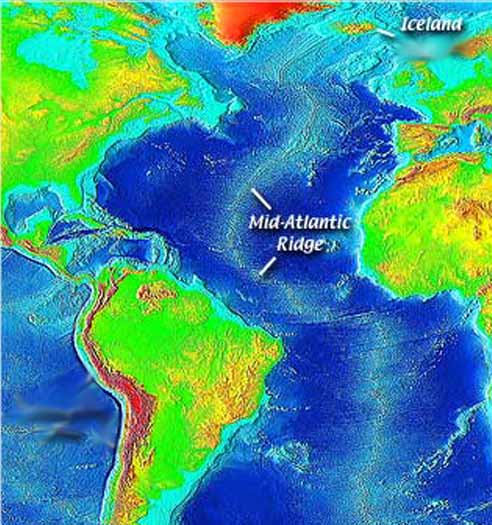Mid-Atlantic Ridge
A MID-OCEAN RIDGE is a system of rifts and parallel mountain ranges or hills found in all major oceans. It is thought to be the site of upwelling new ocean floor material from Earth's mantle, from which ocean floors are gradually spreading out laterally. The Atlantic ridge is the most striking bottom relief feature of the ATLANTIC OCEAN.
A German oceanographic vessel, Meteor, discovered the ridge. The ridge, which is shaped like the letter “S,” extends for 9,000 mi (144,000 km) across the ocean from north to south, and seldom falls more than 13,290 ft (4,000 m) below sea level. It is a submarine longitudinal rise traversing the ocean from ICELAND in north through the equator to BOUVET ISLAND in the south. The general course of the ridge is parallel to the coastline of the bordering continent and throws off many branching ridges towards the coast. Following the curves of the coastline and remaining in the center of the ocean, it divides the Atlantic into two broad deeper basins on either side, which are further divided into many subbasins The greater part of the ridge is submerged below sea level and its central backbone rises 5,000 to 10,000 ft (1,430 to 3,000 m) above the sea floor. The width of the ridge also varies from north to south. The Northern Atlantic ridge is known as Dolphin rise and the southern part is named Challenger rise.

The ridge, though under the sea level, has many peaks thrust out above the surface of the ocean. These peaks are the islands of the mid-Atlantic, for example, the AZORES and CAPE VERDE Islands. The sharpest peak of the Atlantic ridge is the cluster of islets known as Rocks of St. Paul near the equator. In the South Atlantic, the ridge produces ASCENSION and ST. HELENA islands.
The Atlantic ridge rises near Iceland. Between Iceland and Scotland, this ridge is known as the Wiley Thompson ridge and forms the boundary between the Atlantic and Arctic oceans. South of the continental shelf of GREENLAND and Iceland, the ridge widens near about 55 degrees N, where the depth of water is between 7,000 and 10,500 ft (2,000 and 3,000 m). This part is known as Telegraph plateau.
To the west of this plateau near 40 degrees N, the ridge bifurcates toward the Newfoundland coast bounded by the contour of 10,500 ft (3000 m). It is known as the Newfoundland rise. Moving southward in the middle of the ocean up to 12 degrees N, the Central Atlantic ridge follows the southwest direction between the coast of Africa and America. Here it is seldom broken and disrupted. South of 40 degrees N, the Atlantic ridge widens toward the coast of Africa, and here the Azores rise bifurcates from the Central ridge. At the equator, the Sierra Leone rise bifurcate toward the northeast coast of Africa, and the Para rise moves to northwest coast of South America.
At 10 degrees S, the Guinea rise, formed by a contour that is 10,500 ft (3,000 m) deep and less, runs northeast toward the Guinea coast. The ridge bifurcates near 40 degrees S, where the Central ridge has the maximum breadth of 600 mi (960 km). Walvis Ridge is bifurcated from here and merges into the African continental shelf. To the west, the Rio Grande rise is between 10,500 and 14,000 ft (3,000 and 4,000 m) and moves toward the coast of South America to 30 degrees S. Here is the Bromley Plateau, at a depth of 2,437 ft (697 m). After 40 degrees S, the central ridge moves toward the southeast and forms Meteor Bank and Cape Swell, near 45 degrees S. It proceeds toward the Cape of Good Hope, south of which it is known as the Mid Atlantic-Antarctic ridge.
The origin of the ridge is attributed to compression and continental drift. The evolution of the mid-Atlantic rise could be dated back to the Pliocene age. The volcanoes are found on the central ridge from Iceland to Bouvet. Some differential horizontal movement is in progress here. Such movements bring strips of crystal rocks near the sea level. The pattern of the Atlantic floor is suggestive of east-west stretching. It is postulated that the horizontal mantle motion between the zone of rising mantle rock (midocean ridge) and sinking rock (beneath the island and mountain arcs) exerts a dragging force on the lithospheric plates.